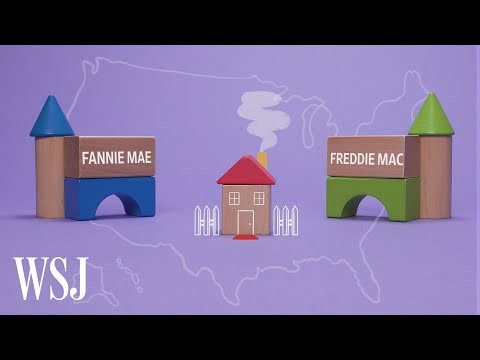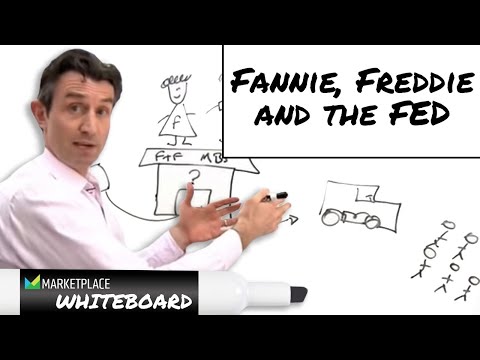In the landscape of American homeownership, two colossal figures cast a long shadow: Freddie Mac and Fannie Mae. Beneath their canopy, a complex interplay unfolds—financial institutions, government policy, and the dreams of countless individuals converge. Today, let’s unravel some of these threads and glean the vital insights they hold for anyone sailing the sometimes turbulent waters of the mortgage market.

Untangling the Roles of Freddie Mac and Fannie Mae in Today’s Economy
You might’ve heard these names thrown around quite a bit, often together, like a financial peanut butter and jelly. But what is Fannie Mae and her brother Freddie Mac exactly? And more importantly, why should you care?
Born from the crucible of Great Depression-era reforms, Fannie Mae – officially the Federal National Mortgage Association (FNMA) – stepped onto the stage in 1938. It was a time of economic instability, and the housing market was no exception. Enter Fannie Mae, designed to ensure a reliable stream of funding for mortgages nationwide. Nearly 30 years later, in 1970, Freddie Mac – or the Federal Home Loan Mortgage Corporation (FMCC) – appeared on the scene, aimed at bolstering the availability of home loans.
They’re a dynamic duo with a shared mission: to infuse the mortgage market with liquidity, stability, and affordability. They achieve this by buying mortgages from a raft of banks and lending institutions, repackaging them as securities, and selling them to investors on the secondary market. Voila! Lenders get a fresh influx of cash to make more loans.
Key Operational Differences:
Here’s a juicy nugget for you: even though they walk and talk similarly, they play in different sandboxes. Fannie Mae typically cozies up with larger commercial banks while Freddie Mac often holds hands with the smaller banks and credit unions. This distinction shapes the housing market in subtle but significant ways.

Fannie Mae’s Influential Presence in the Housing Market
Advancing Affordable Housing Goals:
Fannie Mae isn’t just a faceless entity moving money around—it’s a crusader for the common person. The HomeReady loan program, for instance, is a beacon of hope for applicants not flaunting hefty paychecks; they can’t be earning more than 80% of the area’s median income to qualify.
Impact Analysis:
Let’s look at the numbers, shall we? It’s no secret that the Fannie Mae housing market footprint is huge. Her tentacles of influence reshape homebuying trends with every move, fostering homeownership for a more diverse cross-section of society. With statistical data in the mix, the big picture is undeniable: Fannie Mae molds the market, making the American dream more tangible for many.

| Aspect | Fannie Mae (Federal National Mortgage Association) | Freddie Mac (Federal Home Loan Mortgage Corporation) |
|---|---|---|
| Established | 1938 | 1970 |
| Buying Precedence | Tends to buy loans from larger commercial banks and lenders. | Often buys loans from smaller banks and credit unions. |
| Conservatorship | Under conservatorship since September 2008; building capital reserves for an expected exit. | Similarly, under conservatorship with plans for an eventual exit. |
| Nicknames | Derived from ‘FNMA’. | Derived from ‘FMCC’. |
| Credit Score Requirement | Minimum of 620 for fixed-rate; 640 for adjustable-rate mortgages. | Minimum of 620 for most loans. |
| Down Payment | As low as 3%; at least 20% to avoid mortgage insurance. | Typically 3% minimum requirement; 20% to avoid private mortgage insurance. |
| Special Loan Programs | HomeReady loan for applicants earning no more than 80% of area median income. | Home Possible loan for applicants not exceeding the area’s average income. |
| Market Role | To provide liquidity, stability, and affordability in the mortgage market. | To ensure a steady and reliable source of mortgage funding. |
| Mortgage Market Support | Backs around 70% of the mortgage market (as of 2023). | Similarly backs around 70% of the mortgage market (as of 2023). |
| Investor Status | Shareholder-owned but under government conservatorship; stocks expected to trade on public exchanges post-conservatorship. | Shareholder-owned but in conservatorship with investor anticipation for tradable stocks post-conservatorship. |
| Historical Impact | If allowed to fail, it would have risked collapsing the housing market, hence the 2008 government intervention. | Like Fannie Mae, its failure could have paralyzed the financial system, leading to government control. |
| Loan Purchase Focus | Buys conventional mortgages and supports a wide range of housing finance. | Focuses on keeping the mortgage market fluid with its purchasing power. |
The Evolving Landscape of Freddie Mac and Fannie Mae in Mortgage Financing
Post-2008’s cataclysmic financial quake, these institutions found themselves in the conservatorship bear hug. As of 2022, they’re still there, but don’t think for a moment that they’ve been napping. Post-Conservatorship Strategies are in play: building capital reserves to shimmy out of Uncle Sam’s protective embrace.
Technological Innovations and Efficiency:
Moreover, these mortgage mammoths are tech-savvy. They’re digitizing the mortgage landscape, turning what once was a sluggishly analog process into a flurry of efficiency. From risk assessment algorithms to streamlined application platforms, they are shaking the Etch A Sketch to revolutionize the home loan experience.

What Is Fannie Mae: Dissecting Its Role Beyond Financing
Education and Resources for Homebuyers:
But here’s the kicker—not only does Fannie Mae deal in dollars and cents, but it also peddles in knowledge. It dishes out homebuyer guides and nifty mortgage calculators to demystify the whole process. Because let’s face it, without a bit of handholding, wading through mortgage options is about as easy as nailing jelly to a tree.
Analysis of Fannie Mae’s Community Impact:
Beyond the spreadsheets and calculators, Fannie Mae’s slingin’ hope and opportunity. It’s partnering up with community groups, spearheading projects that aren’t just about putting roofs over heads—they’re building vibrant, sustainable communities.

Investigating Fannie Mae and Freddie Mac’s Influence on Mortgage Rates and Product Innovation
Ever wonder about the voodoo that determines your mortgage interest rates? Fannie Mae and Freddie Mac are the high priests and priestesses. Their policies and practices send ripples across the pool, nudging interest rates this way and that.
Spotlight on Product Development:
And, honey, they’re not content just stirring the pot—they’re throwing in a dash of this, a sprinkle of that. Creating competitive, dazzling mortgage products to seduce lenders and borrowers alike. Just when you think you’ve seen it all, they pull a newfangled loan program out of the hat, wowing the crowd.
Conclusion: The Contemporary Significance of Freddie Mac and Fannie Mae
Wrapping this up, Freddie Mac and Fannie Mae aren’t just acronyms you skim over in the business section of the paper. Sure, they’ve got their hands deep in the mortgage cookie jar, but they ensure there are enough cookies to go around, so you and yours get a bite of homeownership.
The Future Ahead:
Strap in; it’s a bumpy ride ahead. New regulations are always on the horizon, the markets are as stable as a three-legged table, and homebuyer needs are evolving faster than you can say “adjustable-rate mortgage.” Freddie and Fannie will have to roll with the punches, adapt, and keep the heart of the American housing market beating strong.
Now, don’t you feel all enlightened and ready to conquer the mortgage world? Make smart choices, friends, and remember: your home isn’t just where you hang your hat; it’s the cornerstone of your financial empire. Whether you’re sliding into your favorite pair of Slides men, slipping your feet into those trusty nurse shoes after a long shift, or lounging in that oversized t-shirt, your home is your sanctuary. But always keep in mind, the path to homeownership can be a rocky one; make sure you’re clear on whether your mortgage is conforming or non-conforming.
Before you march into your mortgage adventure, be sure to check out the latest mortgage interest rate forecast to avoid any future head-scratching. After all, nobody wants to be left wondering When will The interest rates go down as you watch your monthly payment tick up. Instead, stay a step ahead with Freddie Mac and Fannie Mae in tow, your twin scouts on this economic expedition.
Fun Trivia and Interesting Facts About Freddie Mac and Fannie Mae
Let’s dive right into some amusing tidbits and fascinating nuggets about Freddie Mac and Fannie Mae, the twin titans of the home mortgage world. Prepare for some surprising twists that’ll make these institutions sound less like financial behemoths and more like characters in an offbeat tale of housing!
Fannie Mae’s Famous Faces
Did you know that Fannie Mae doesn’t just keep an eye on the housing market, but it’s also been known to watch the stars? Picture this: if Fannie Mae were a casting director, it might have spotted talent like Morfydd Clark before anyone else did. You know, the kind of fresh face that lights up the screen in period dramas and fantasy epics. Well, not really, but it’s a fun thought, right?
Freddie Mac’s Fashion Faux Pas
Hold onto your hats, folks. Freddie Mac may be all about numbers and loans, but imagine if it decided to set a new trend by swapping spreadsheets for “oversized t-shirts”. What a sight that would be – financial analysts strutting around the office in comfy cotton tees that you could camp under! While Freddie Mac won’t be featured in any fashion magazines anytime soon, we can always dream of a world where comfort trumps corporate attire.
Did You Say Twins?
Oh, boy, does the tale of Freddie Mac and Fannie Mae sound like something out of a sitcom or what? You’d think they were twins separated at birth and reunited to conquer the world of mortgages. They’re like the peanut butter and jelly of home loans, inseparable and oh-so-smooth when spreading their influence across the housing market.
Riding the Roller Coaster
Buckle up! The history of Freddie Mac and Fannie Mae is wilder than a roller coaster at your local amusement park. One minute they’re on top of the world, the next they’re free-falling into a bailout net. It’s been a bumpy ride with more loops than you can count, yet they somehow always end up back on track, ready for the next round of economic thrill-seeking.
The Unsung Heroes
Last but not least, let’s give a shout-out to the hardworking folks behind the scenes at Freddie Mac and Fannie Mae. They’re the unsung heroes, crunching numbers and navigating regulations like pros. They’re like magicians pulling affordable mortgage rates out of their hats, making homeownership dreams come true. Hats off to these wizards of the financial realm!
Well, there you have it – a dollop of humor and a splash of imagination mixed with morsels of mortgage madness. Freddie Mac and Fannie Mae might not be headed for a fashion runway or starring in blockbuster movies, but they’ve definitely earned a spot in the quirky corners of financial folklore. Keep these fun facts in your back pocket – they’re perfect for breaking the ice at your next networking event or impressing a date with your offbeat knowledge of government-sponsored enterprises. Who knew mortgages could be this entertaining?

What is difference between Fannie Mae and Freddie Mac?
Ah, Fannie Mae and Freddie Mac—the dynamic duo of the mortgage world! They’re both government-sponsored enterprises (GSEs) that buy mortgages from lenders, but here’s the kicker: They’ve got different ‘owners’ and slightly different missions. Fannie Mae typically deals with conventional loans from larger banks, while Freddie Mac often snaps up loans from smaller banks.
What happened with Fannie Mae and Freddie Mac?
Hold the phone—Fannie Mae and Freddie Mac grabbed headlines during the 2008 financial crisis. They got into a heap of trouble when the housing market tanked, largely due to their portfolios stuffed with risky loans. The government had to swoop in with a mega bailout, putting them under federal conservatorship to keep them afloat.
Why is it called Fannie Mae and Freddie Mac?
Curiously enough, these names sound like your friendly next-door neighbors, but they’re actually acronyms! Fannie Mae stands for the Federal National Mortgage Association (FNMA), and Freddie Mac stands for the Federal Home Loan Mortgage Corporation (FHLMC). They were nicknamed for easier chit-chat around the water cooler.
Who qualifies for Fannie Mae and Freddie Mac?
To qualify for a Fannie Mae or Freddie Mac loan, you’ll need to meet certain credit score and income requirements, and the property must be your primary residence, second home, or an investment property. Basically, not everyone’s invited to the party, but many can get through the door with the right financial fit.
Is my loan owned by Fannie Mae or Freddie Mac?
Wondering if your loan is with Fannie Mae or Freddie Mac? Well, you can usually check online through their loan lookup tools—super handy! Just key in your info, and voilà, you’ll know which one’s got your back (or your mortgage).
Do all mortgages go through Fannie Mae and Freddie Mac?
Not all mortgages waltz through the doors of Fannie Mae and Freddie Mac—some defy the norm. These big players mainly handle the conventional loan dance floor, but government-insured loans like FHA, VA, and USDA loans follow a different tune and aren’t bought by them directly.
What started the downfall of Fannie Mae?
The downfall of Fannie Mae? Oh boy, it’s like a Shakespearean tragedy. It all started with the housing bubble’s burst and a surge in mortgage delinquencies. They were heavy on high-risk loans, which, when things went south, led to a monstrous financial quagmire, and the government had to jump in to bail them out.
What exactly does Fannie Mae do?
Fannie Mae’s like a superhero for the housing market—it snaps up mortgages from lenders, bundles them into securities, and guarantees them. This keeps the mortgage machine humming by ensuring lenders have the dough to give out new loans.
Why did Fannie Mae fail?
Why did Fannie Mae fail? Well, once upon a not-so-magic time, they were gobbling up risky loans like there was no tomorrow. When the housing market did an Olympic-sized belly flop, these loans went bad, and they were left holding the bag—without enough capital to cover the losses.
Is Fannie Mae a FHA loan?
Nope, Fannie Mae isn’t an FHA loan, folks. It’s a government-sponsored enterprise that deals with conventional loans. On the other hand, FHA loans are government-insured and designed to help the little guys with lower down payments and credits.
Does Freddie Mac still exist?
Does Freddie Mac still exist? You bet it does! Despite taking a dive during the 2008 crisis, it’s still kicking, operating under government conservatorship to help keep the mortgage market stable and accessible.
Does Fannie Mae own my mortgage?
If you’re itching to know whether Fannie Mae owns your mortgage, just swing by their website and use their loan lookup tool. It’s like the mortgage version of ‘Where’s Waldo?’—with just a few clicks, you’ll find out if they’re the ones holding the keys to your loan.
Is Freddie Mac for low income?
Freddie Mac isn’t specifically for low-income borrowers, but don’t fret—it’s got programs aiming to make homeownership more attainable for those with modest incomes. They’re like the Robin Hood of the mortgage market, in a way.
Who owns Fannie Mae and Freddie Mac?
As for who owns Fannie Mae and Freddie Mac, they’re kind of unique beasts in the wild world of finance. They’re publicly traded companies but have been under the thumb of the U.S. government since the 2008 hoopla, making Uncle Sam their conservator through the FHFA.
What credit score is needed for Freddie Mac?
Now, about your credit score for Freddie Mac—let’s not beat around the bush. Generally, you’re gonna want a score of 620 or more to get into the party. But hey, the higher your score, the better the chances of snagging a sweet deal on your mortgage.
What are the major differences between Fannie Mae Ginnie Mae and Freddie Mac?
Ready for a GSE throwdown? Fannie Mae and Freddie Mac’s big shtick is buying conventional mortgages, but Ginnie Mae’s got a different groove—it guarantees securities backed by FHA, VA, or USDA loans. They’re all here to keep the mortgage world spinning, but they each play their own special tune.
Who or what are Fannie Mae and Freddie Mac and why are they so important?
Fannie Mae and Freddie Mac aren’t just big names; they’re the pillars of the U.S. housing market. They buy up mortgages, giving lenders more moolah to hand out new loans, and make sure homeownership is within reach for many. They’ve got their fingers in nearly half the mortgage pie—talk about a full plate!
Why do banks sell mortgages to Freddie Mac?
Why do banks sell mortgages to Freddie Mac? Cash is king, and selling to Freddie Mac gives banks more green to lend out. It’s like passing the baton in a relay race, keeping the lending marathon going strong.
What loans does Fannie Mae not purchase?
Fannie Mae can be picky, no doubt. It typically won’t purchase loans with high loan-to-value ratios without mortgage insurance, or those that don’t meet their guidelines, like non-conforming jumbo loans. They have their standards, after all.



